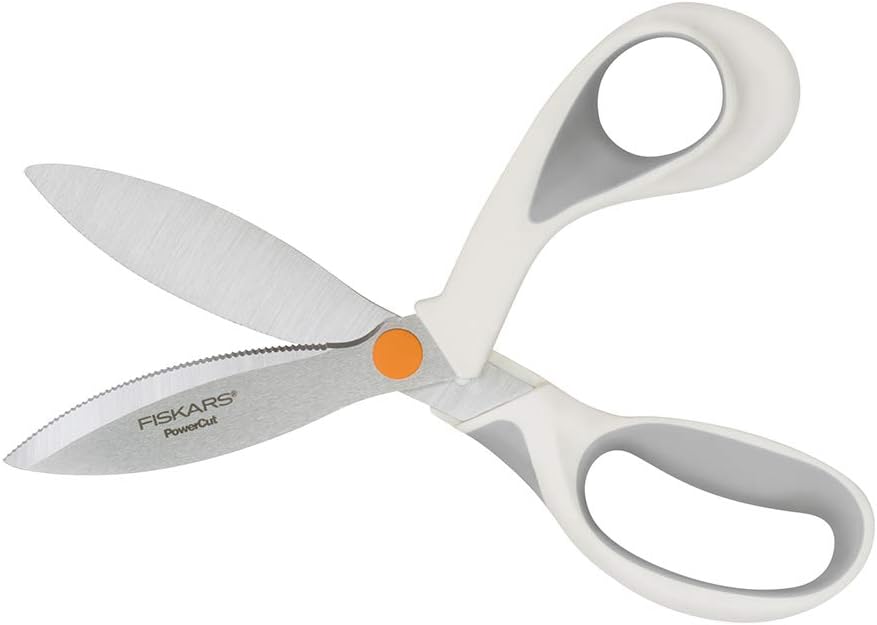If you’ve ever tackled a DIY project or worked with packaging, you know how frustrating it can be to cut through thick cardboard with dull, inefficient scissors.
Whether it’s for crafting, moving, or organizing your space, the right tools can make all the difference.
So, what’s the secret to cutting thick cardboard with ease? You need the right pair of scissors.
In this guide, we’ll dive into everything you need to know about finding the best scissors for cutting thick cardboard.
From understanding the essential features to avoiding common mistakes, I’ve got you covered. So, grab a cup of coffee, and let’s get started on this cutting-edge journey!
Choosing the Right Scissors
Before we dive into specifics, let’s take a moment to understand why choosing the right pair of scissors is so important for cutting thick cardboard. Cardboard can be stubborn it’s dense and tough, often resisting the simplest cuts.
If you’re using the wrong tool, you might end up with jagged edges, sore hands, or even damaged scissors. That’s not the outcome you want, especially if you have multiple pieces to cut or need precision.
Scissors designed specifically for cutting thick cardboard are built to handle these challenges. They’re crafted with sharp, durable blades, ergonomic handles, and a sturdy design that makes cutting through cardboard a breeze.
By the end of this guide, you’ll know exactly what to look for, and I’ll even help you avoid some common pitfalls.
| Product Image | Product Name | Features | Price |
|---|---|---|---|
 |
HURRICANE 10 Inch Aviation Tin Snips | Versatile Cutting Performance Durable Chrome Vanadium Blades Built-in locking latch keeps blades safely closed during storage or transport Rubberized grip ensures comfort and control during extended use |
Check Price |
 |
stedi 9-Inch Scissor Heavy-Duty, All-Purpose Scissor | Premium 420J2 Stainless Steel Blades Finely Serrated Blade Edge Adjustable Cutting Range & Wire Groove Ergonomic TPR Handle with Safety Lock |
Check Price |
 |
Fiskars SoftGrip PowerCut Fabric and Mixed Media Scissor | Enhanced Cutting Power Heavy-Duty Precision Blades Comes with a durable sheath to prevent damage and extend blade life Clean Tip-to-Grip Cutting |
Check Price |
 |
ENGINEER PH-57 Versatile Scissor | Exceptional Cutting Versatility Durable 2-in-1 Stainless Steel Blades Enhanced Thumb Pad Design Protective Blade Cap |
Check Price |
 |
Utility Scissors Heavy Duty | Powerful Multi-Material Cutting Universal Utility Across Spaces Serrated Blade for Grip & Precision Oversized Ergonomic Handle |
Check Price |
 |
DUROX – Heavy Duty Scissor | Multi-Zone Cutting Versatility 30% Boosted Cutting Power Maximum Material Capacity Extra-large, non-slip finger holes offer a secure grip |
Check Price |
Key Features to Look For in Scissors for Thick Cardboard
To select the best scissors for thick cardboard, you need to understand the unique features that will make your cutting tasks easier. Here’s a breakdown of the essential characteristics:
1. Sharpness of the Blades
This is arguably the most important factor. The sharper the blade, the easier it will be to cut through thick cardboard without much force.
Look for scissors with high-carbon steel or stainless steel blades, as these materials tend to retain sharpness longer.
2. Blade Length
For thick cardboard, you’ll need scissors with blades that are long enough to provide leverage but not so long that they’re unwieldy.
Generally, blades around 8 to 10 inches are ideal for cutting thick material. A longer blade offers more cutting surface, but make sure it’s not too large to control comfortably.
3. Ergonomic Handles
When you’re cutting through thick cardboard, your hands will be doing a lot of work. The right handles can make a big difference in comfort and control.
Look for handles that are padded or designed with ergonomics in mind. Soft grips or spring-loaded handles can reduce hand fatigue, especially for extended cutting sessions.
4. Durability
Cardboard isn’t just thick; it can also be tough on your tools. Scissors with reinforced blades or handles made from durable materials like heavy-duty plastic or metal can ensure they stand up to the strain.
5. Safety Features
While safety might not seem like a top priority when using scissors, it’s always worth considering. Some scissors come with built-in safety locks or blade covers, which prevent accidents when the scissors are not in use.
Step-by-Step Guide to Cutting Thick Cardboard
Now that you know what to look for, let’s talk about how to cut thick cardboard effectively using your scissors.
Step 1: Position Your Cardboard
Before you start cutting, make sure the cardboard is on a flat surface. Ideally, you want it on a cutting mat to protect your table or workspace, but any flat, sturdy surface will work. If your cardboard is large, it may help to score the cardboard first to create a guide for your cut.
Step 2: Grip Your Scissors Correctly
Ensure that you have a firm grip on the scissors. Keep your thumb in the top hole and your fingers in the bottom. If you’re using heavy-duty scissors, make sure your grip is firm but relaxed don’t strain your hand.
Step 3: Start Cutting Slowly
Place your scissors at the edge of the cardboard and start cutting slowly. It’s important not to rush this step, as cutting too fast can lead to jagged edges or uneven cuts. Follow the scored line (if you’ve scored the cardboard), or cut along your desired path.
Step 4: Apply Steady Pressure
As you cut, apply steady pressure to the scissors. Don’t force the blades let them do the work. If your scissors are sharp and your technique is correct, you’ll find the cardboard cutting quite easily. If you hit a tough spot, stop and adjust your angle slightly to avoid dulling your blades prematurely.
Step 5: Make Multiple Passes if Needed
If the cardboard is really thick, you may need to make a few passes instead of trying to cut through it in one go. Forcing the scissors through all at once can result in uneven cuts or damage to the tool.
Common Mistakes to Avoid When Cutting Cardboard
Cutting thick cardboard isn’t always as straightforward as it seems, and there are a few common mistakes I see people make all the time. Here’s what to watch out for:
1. Using Dull Scissors
This one’s obvious, but it’s worth repeating: dull scissors will make cutting difficult and lead to frustration.
Dull blades will not only make the job harder but also create jagged cuts that might ruin your cardboard.
2. Forcing the Scissors Through the Cardboard
I know it’s tempting to just muscle through thick cardboard, but this is a surefire way to damage your scissors.
If you’re using a pair of scissors that isn’t suited for thick cardboard, forcing them to cut will only dull the blades. Instead, use the right tool and let it do the work.
3. Improper Handling
Another common mistake is not using the proper grip or body positioning. If your grip isn’t right, you could end up straining your hand or wrist, leading to discomfort or injury.
Make sure your fingers are securely placed in the handles and that you’re cutting at a comfortable angle.
4. Not Prepping the Cardboard
Skipping the preparation step can make cutting more difficult. Always make sure the cardboard is clean and flat. Wrinkles, bends, or excessive creases can make it harder to get a clean cut.
Best Types of Scissors for Cutting Thick Cardboard
Now that you know what to look for and what to avoid, let’s take a look at the best types of scissors based on different needs.
The type of scissors you choose depends on your cutting frequency, the thickness of the cardboard, and how much leverage you need.
| Type of Scissors | Best For | Why It’s Great |
| Heavy Duty Scissors | Frequent cutting of thick cardboard | They offer a long blade length and durability, perfect for tough jobs. |
| Craft Scissors | DIY projects and crafting | Usually smaller with precision tips, great for detailed cuts. |
| Spring-Loaded Scissors | Reducing hand strain | These scissors open automatically, making them easy to use for extended periods. |
| Utility Scissors | Cutting through multi-layered cardboard | Often stronger than regular scissors and can cut through thicker materials. |
Maintaining Your Scissors for Long-Term Use
To keep your scissors in top shape, regular maintenance is a must. Here are some simple steps for ensuring your scissors stay sharp and functional:
1. Sharpening the Blades
If your scissors begin to lose their sharpness, consider sharpening them. You can use a sharpening stone or a specialized scissor sharpener. If you’re not comfortable doing this yourself, you can also take them to a professional sharpener.
2. Cleaning the Blades
After each use, wipe down the blades with a clean cloth to remove any cardboard dust or sticky residues. Over time, these can affect the sharpness of the blades or cause rusting if left unattended.
3. Lubricating the Hinges
The hinges of your scissors need lubrication to ensure smooth movement. A few drops of oil can keep everything running smoothly and prevent rust.
Conclusion: Cutting Cardboard with Confidence
Choosing the best scissors for cutting thick cardboard doesn’t have to be difficult. By focusing on key features like sharpness, blade length, and ergonomic handles, you can make the cutting process quicker, easier, and more enjoyable.
I hope this guide helps you make an informed decision and gives you the confidence to tackle your next cardboard cutting task.
- Always choose scissors that are designed for thicker materials like cardboard.
- Pay attention to sharpness, durability, and ergonomic features for a better cutting experience.
- Avoid common mistakes like using dull scissors or forcing the blades through tough materials.
- Regular maintenance will ensure your scissors last longer and perform at their best.
If you found this guide helpful, feel free to share it with friends who might be struggling with the same issue. Have any questions or tips of your own? Drop a comment below—I’d love to hear your thoughts!
FAQs
- What’s the difference between regular scissors and heavy-duty scissors for cutting cardboard?
- Regular scissors are typically too small and not built for tough materials like cardboard. Heavy-duty scissors have longer, stronger blades that make cutting through thick cardboard much easier.
- How do I sharpen my scissors for cutting cardboard?
- You can use a sharpening stone or take your scissors to a professional sharpening service. Regular sharpening will ensure that your scissors stay sharp enough to cut through thick cardboard.
- Can I use kitchen scissors to cut thick cardboard?
- While kitchen scissors might work in a pinch, they are not designed for cutting thick cardboard and will likely become dull quickly. It’s better to use specialized heavy-duty scissors for the job.
- How do I prevent my scissors from rusting?
- Make sure to wipe them down after every use and apply a small amount of oil to the hinges. Store them in a dry place to avoid moisture buildup.
- Are there any safety precautions I should take when using scissors for thick cardboard?
- Always cut away from your body and keep your hands clear of the cutting path. If you’re using a sharp tool, ensure that it’s safely stored when not in use.


